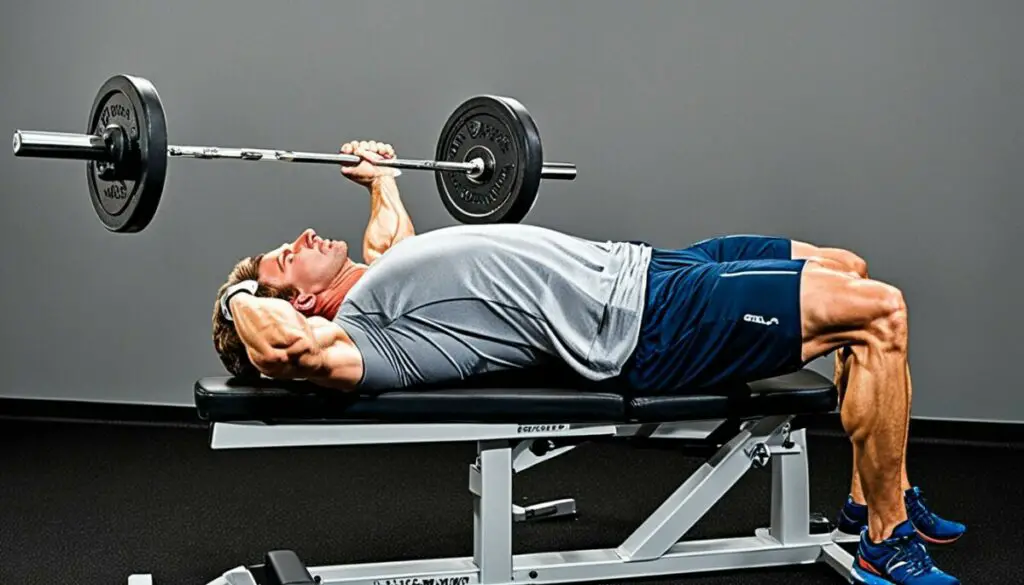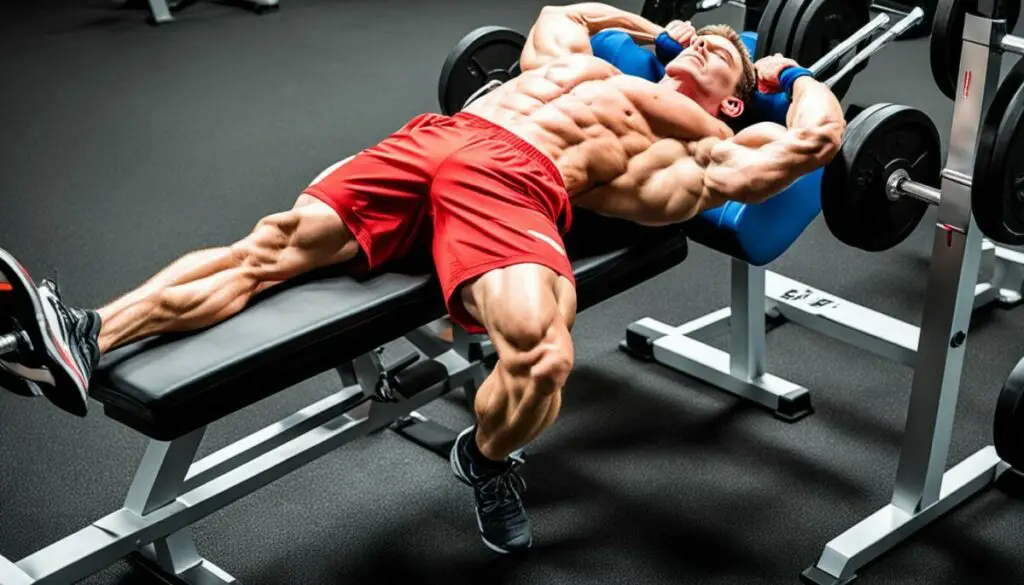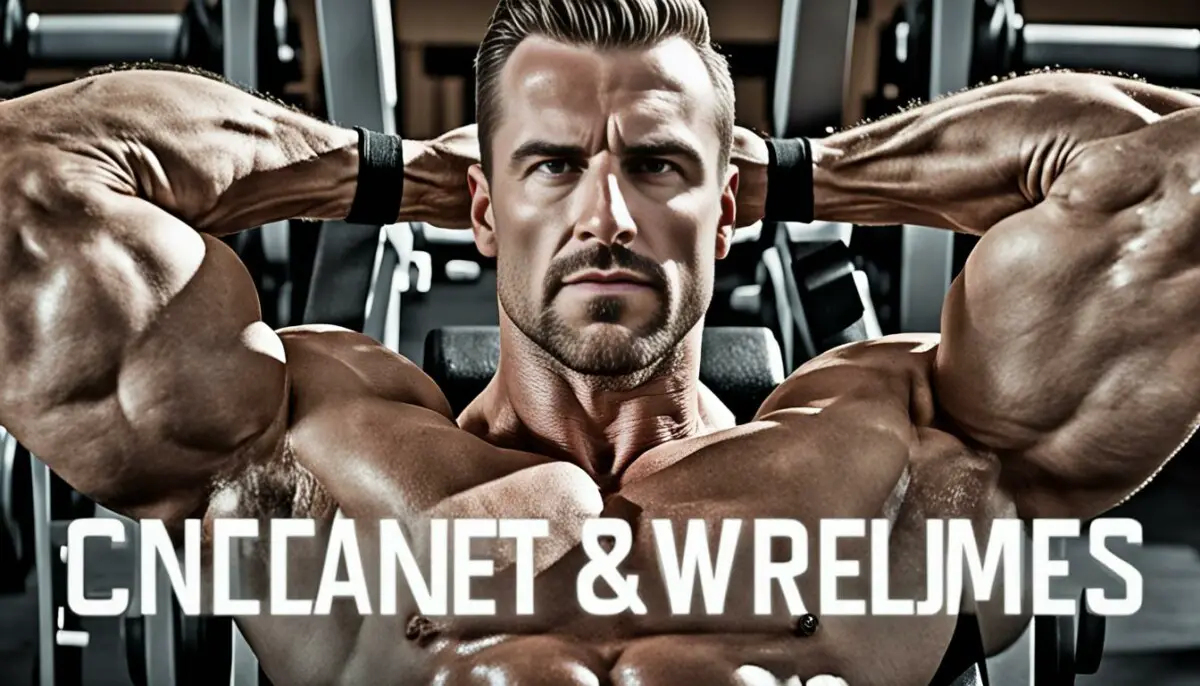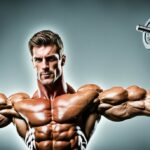Last Updated on 3 months by Francis
The incline bench press is a highly effective exercise for targeting the upper body muscles and achieving significant gains. By incorporating incline bench exercises into your workout routine, you can experience a wide range of benefits that will enhance your upper body strength, muscle development, and overall fitness.
The incline bench press specifically targets the upper chest muscles, shoulders, and triceps, making it an excellent variation of the traditional bench press. The incline angle of the bench places greater emphasis on the upper pectoral muscles, allowing for improved upper chest development and a more sculpted appearance.
Additionally, the incline bench press helps to balance shoulder strength by engaging the front deltoids. Strengthening these muscles contributes to better overall shoulder development, stability, and reduced risk of injuries.
Moreover, incline bench exercises translate into enhanced functional strength. The movement pattern of the incline bench press mimics real-world pushing activities, making it a practical exercise for improving everyday strength and performance.
Contents
Key Takeaways:
- The incline bench press targets the upper chest muscles, shoulders, and triceps, leading to improved upper body strength and muscle development.
- By incorporating incline bench exercises, you can achieve a well-rounded and sculpted chest with greater emphasis on the upper pectoral muscles.
- Engaging the front deltoids during the incline bench press helps to balance shoulder strength and reduce the risk of imbalances and injuries.
- Incline bench exercises contribute to enhanced functional strength by simulating real-world pushing activities, improving daily performance and overall strength.
- Incorporate variations of the incline bench press, such as incline dumbbell press or reverse grip incline bench press, to target different muscle groups and further enhance your upper body gains.
Improved Upper Chest Development
One of the primary benefits of including the incline bench press in your workout routine is improved upper chest development. The incline angle of the bench places greater emphasis on the upper chest muscles, resulting in better overall development and aesthetics. This exercise specifically targets the clavicular head of the pectoralis major, helping to create a well-rounded and sculpted chest.
When performing the incline bench press, the muscles responsible for upper chest development, such as the clavicular fibers of the pectoralis major, are recruited more effectively compared to the flat bench press. The inclined position of the bench places the shoulders at a slight angle, engaging the upper chest muscles with greater intensity and focus. This targeted stimulation contributes to increased muscle growth and definition in the upper chest region.
By incorporating the incline bench press into your chest workout routine, you can specifically target the upper chest muscles and address any imbalances in chest development. This exercise can help create a more balanced and symmetrical chest, enhancing the overall aesthetics of your physique.
| Exercise | Muscles Targeted |
|---|---|
| Incline Bench Press | Clavicular head of the pectoralis major, anterior deltoids, triceps |
| Flat Bench Press | Pectoralis major (overall), anterior deltoids, triceps |
| Push-Ups | Pectoralis major (overall), anterior deltoids, triceps |
It’s important to note that while the incline bench press primarily targets the upper chest muscles, it also engages other adjacent muscles such as the anterior deltoids and triceps, contributing to overall upper body strength and development. Incorporating a variety of exercises and training modalities that target different muscle groups can further enhance your upper body gains and promote a well-rounded physique.
Next, we’ll explore how the incline bench press can help improve shoulder strength and stability.
Balanced Shoulder Strength

Another advantage of the incline bench press is the balanced shoulder strength it can provide. This exercise engages the front deltoids more than the flat bench press, contributing to balanced shoulder development. Strong and stable shoulders are crucial for overall upper body strength and can help reduce the risk of injuries.
When performing the incline bench press, the angle of the bench targets the front deltoids, which are responsible for shoulder flexion and keeping the arms parallel to the ground. This activation helps to strengthen and develop the front portion of the shoulders, contributing to a balanced physique and improved performance in various upper body exercises.
Additionally, by using a grip that is wider than shoulder-width apart, the incline bench press also engages the side deltoids to a greater extent. This helps in building overall shoulder strength and stability, enhancing your ability to perform pushing movements with efficiency and power.
By incorporating the incline bench press into your workout routine, you can ensure that your shoulder development is well-rounded and balanced. This can aid in preventing muscle imbalances and reducing the risk of shoulder injuries that can occur due to weak or underdeveloped muscles.
“The incline bench press is an excellent exercise for targeting the front deltoids and promoting overall balanced shoulder strength. It helps to build stability in the shoulder joints and improve functional movement patterns, enhancing your performance in various lifting and pushing activities.”
– Dr. Sarah Johnson, Physical Therapist
To further enhance your shoulder strength and stability, consider incorporating exercises that target the other shoulder muscles, such as the side deltoids and rear delts. This can be achieved through exercises like lateral raises, rear delt flyes, and face pulls. By combining these exercises with the incline bench press, you can develop well-rounded shoulder strength and prevent muscle imbalances.
Tips for Balanced Shoulder Development:
- Include the incline bench press in your upper body routine at least once or twice a week.
- Vary your grip width to engage different muscles in the shoulder complex.
- Focus on maintaining proper form and control throughout the movement.
- Gradually increase the weight and intensity as you become stronger and more comfortable with the exercise.
- Consider consulting with a qualified fitness professional for personalized guidance and to ensure proper technique.
Muscles Targeted by the Incline Bench Press
| Muscle | Primary Activation |
|---|---|
| Upper Chest (Clavicular Pectoralis Major) | High |
| Front Deltoids (Anterior Head) | High |
| Side Deltoids (Lateral Head) | Moderate |
| Triceps Brachii | Moderate |
| Serratus Anterior | Low |
| Trapezius (Upper Fibers) | Low |
The incline bench press primarily targets the upper chest, front deltoids, and triceps, with moderate activation of the side deltoids. Other supporting muscles, such as the serratus anterior and upper fibers of the trapezius, also contribute to the movement but at a lower activation level.
Enhanced Functional Strength

The incline bench press is not only an effective exercise for building muscle, but it also has practical applications in improving functional strength. The movement pattern of the incline bench press closely mimics pushing activities that we encounter in everyday life, such as pushing open doors or pushing objects away from our body. By regularly incorporating incline bench press variations into your workout routine, you can develop the functional strength needed to tackle these real-world challenges with ease.
One of the best ways to enhance your functional strength is by incorporating incline bench press variations into your workouts. These variations target different muscle groups and provide a well-rounded approach to functional strength training. Two popular incline bench press variations are the incline dumbbell press and the reverse grip incline bench press.
Incline Dumbbell Press
The incline dumbbell press is a great variation that challenges your stabilizer muscles and allows for a greater range of motion compared to using a barbell. By using dumbbells, you can address any strength imbalances between your left and right side and ensure that both sides of your body are equally strong.
Reverse Grip Incline Bench Press
The reverse grip incline bench press is another effective variation that puts even more emphasis on the upper chest muscles. By using an underhand grip, you engage the upper chest muscles in a slightly different way, helping to develop a well-rounded and proportionate chest.
By incorporating these incline bench press variations into your routine, you are not only building muscle but also enhancing your functional strength. This will improve your ability to perform daily tasks that require pushing or pressing movements and help prevent injuries associated with weak upper body strength.
| Variation | Muscles Targeted | Benefits |
|---|---|---|
| Incline Dumbbell Press | Upper chest, shoulders, triceps | Improved range of motion, targets stabilizer muscles |
| Reverse Grip Incline Bench Press | Upper chest, shoulders, triceps | Emphasizes upper chest muscles, creates proportionate development |
Proper Setup and Technique

To perform the incline bench press effectively and safely, it is important to set up the bench correctly. Follow these guidelines to optimize your incline bench press technique:
- Bench angle: Adjust the bench angle between 30 and 45 degrees. Choose an angle that suits your goals and comfort level. A higher angle will increase the emphasis on the upper chest muscles, while a lower angle will engage the shoulders and triceps more.
- Hand placement: Position your hands slightly wider than shoulder-width apart on the barbell. This grip allows for better stability and engages the chest muscles effectively. Make sure your wrists are straight and aligned with your forearms.
- Foot positioning: Place your feet firmly on the ground, slightly wider than shoulder-width apart. This wider stance provides a stable base and helps maintain balance during the exercise. Keep your feet flat on the ground throughout the movement.
By following these proper setup and technique guidelines, you can maximize the effectiveness of your incline bench press and reduce the risk of injury.
Executing the Incline Bench Press
Proper execution of the incline bench press involves specific techniques that optimize the effectiveness of this exercise. By following these guidelines, you can ensure maximum muscle engagement and minimize the risk of injury.
Breathing Techniques
Using proper breathing techniques is essential during the incline bench press. Remember to inhale before lowering the bar and exhale while pressing it back up. This controlled breathing pattern helps stabilize your core and enhance your overall performance.
Lowering the Bar
When lowering the bar, focus on keeping your elbows tucked at a 45-degree angle. This position targets the upper chest muscles and reduces strain on the shoulders. Additionally, control the descent of the bar to prevent bouncing, which can compromise form and increase the risk of injury.
Pressing the Bar
As you press the bar back up, push it in a straight line using your chest, shoulders, and triceps. Fully extend your arms without locking your elbows at the top of the movement. This ensures that you are engaging the targeted muscles effectively and maximizing the benefits of the exercise.
“Proper breathing and form are crucial in executing the incline bench press effectively. Take the time to understand and practice these techniques to optimize your upper body gains.”
Common Mistakes to Avoid
During the incline bench press, it’s important to be aware of common mistakes that can hinder your progress and increase the risk of injury. By avoiding these errors, you can maintain proper form and maximize your results:
- Avoid flaring your elbows out to the sides. Keep them tucked at a 45-degree angle to engage the target muscles and maintain stability.
- Avoid arching your lower back excessively. Maintain a natural curve in your spine throughout the exercise to prevent strain and potential back pain.
- Avoid bouncing the bar off your chest. This reduces the effectiveness of the exercise and can strain your muscles and joints. Maintain control throughout the entire range of motion.
By incorporating these techniques and avoiding common mistakes, you can perform the incline bench press with proper form, targeting the desired muscles effectively, and achieving optimal results.
| Common Mistakes | Consequences |
|---|---|
| Flaring elbows out | Reduces the emphasis on the chest muscles and increases the strain on the shoulder joints. |
| Arching the lower back excessively | Puts unnecessary stress on the lower back and jeopardizes proper form. |
| Bouncing the bar off the chest | Decreases muscle activation and increases the risk of injury. |
Incline Bench Press Variations
Looking to spice up your workout routine? Incorporating variations of the incline bench press can add variety and target different muscle groups. Here are three popular variations to try:
Incline Dumbbell Press
The incline dumbbell press is a fantastic variation that allows for a greater range of motion compared to the barbell press. By using dumbbells, you can address any strength imbalances between your sides. This exercise also engages your stabilizer muscles, helping to develop a well-rounded upper body.
Reverse Grip Incline Bench Press
If you want to emphasize your upper chest muscles even more, try the reverse grip incline bench press. By using an underhand grip, you’ll place additional stress on your upper chest and front deltoids. This exercise is an excellent way to target those areas and achieve a more sculpted upper body.
Smith Machine Incline Bench Press
The Smith machine incline bench press is a fantastic option for beginners or those recovering from injury. The Smith machine provides stability and support, allowing you to focus on your form and technique. It’s a great exercise to build strength and gradually progress to more challenging variations.
Remember, incorporating these variations into your workout routine can help you break through plateaus, target specific muscle groups, and keep your workouts interesting. Experiment with different exercises and find what works best for you.
Complementary Exercises
To further develop your upper body strength and balance, it is beneficial to incorporate complementary exercises into your routine. By combining these exercises with the incline bench press, you can achieve a well-rounded upper body workout.
-
Flat Bench Press
The flat bench press is a classic exercise that targets the middle and lower chest muscles. It involves lying flat on a bench with a barbell or dumbbells and pressing the weight up and down. This exercise not only strengthens the chest, but also engages the shoulders and triceps for a comprehensive upper body workout.
-
Overhead Press
The overhead press, also known as the military press, is a compound exercise that primarily targets the shoulders and upper back. It involves pressing a barbell or dumbbells overhead from a standing position. This exercise helps develop shoulder strength and stability, contributing to improved posture and overall upper body strength.
-
Push-ups
Push-ups are a versatile bodyweight exercise that targets multiple muscle groups, including the chest, shoulders, and triceps. They can be performed anywhere and do not require any equipment. By varying hand placement and modifying the angle of your body, you can adjust the intensity and target different areas of the upper body with push-ups.
Conclusion
Incorporating the incline bench press into your workout routine can provide numerous benefits for your upper body development. This compound exercise specifically targets the upper chest muscles, helping you achieve a well-rounded and sculpted chest. Additionally, the incline bench press improves shoulder strength, contributing to balanced upper body development and reducing the risk of injuries.
One of the key advantages of the incline bench press is its ability to enhance functional strength. By simulating real-world pushing activities, this exercise helps improve your overall strength and endurance for everyday activities. To make the most of the benefits, prioritize proper setup and execution techniques, such as maintaining the correct bench angle and employing proper breathing techniques.
To further maximize your upper body gains, consider incorporating variations of the incline bench press into your workouts, such as incline dumbbell press or reverse grip incline bench press. These variations target different muscle groups and add variety to your routine.
Remember, consistency is key. Gradually increase the weight as your strength and form improve, and challenge yourself to reach new fitness goals. With the incline bench press as part of your workout routine, you can achieve a stronger, more defined upper body.
FAQ
What muscles does the incline bench press target?
The incline bench press primarily targets the upper chest muscles, along with the shoulders and triceps.
How does the incline bench press benefit upper chest development?
The incline angle of the bench places greater emphasis on the upper chest muscles, resulting in improved development and aesthetics.
Does the incline bench press help in balancing shoulder strength?
Yes, the incline bench press engages the front deltoids more than the flat bench press, contributing to balanced shoulder development.
What is functional strength, and how does the incline bench press enhance it?
Functional strength refers to the ability to perform everyday movements effectively. The incline bench press simulates pushing activities, making it a practical exercise for improving functional strength.
How should the incline bench be set up for optimal results?
The incline bench should be set at an angle between 30 and 45 degrees. Hand placement should be slightly wider than shoulder-width apart, and feet should be planted firmly on the ground.
What are some key techniques for executing the incline bench press?
Proper breathing techniques, controlled descent, and pressing the bar in a straight line are essential for effective execution. It is important to avoid common mistakes such as flaring elbows and bouncing the bar off the chest.
Are there any variations of the incline bench press?
Yes, variations such as incline dumbbell press, reverse grip incline bench press, and Smith machine incline bench press provide different challenges and target specific muscle groups.
What are some complementary exercises to incorporate with the incline bench press?
Flat bench press, overhead press, and push-ups are excellent exercises to complement the incline bench press and achieve a well-rounded upper body workout.
What are the overall benefits of incorporating the incline bench press into a workout routine?
The incline bench press targets specific muscle groups, improves upper chest development, enhances shoulder strength, and improves functional strength.








